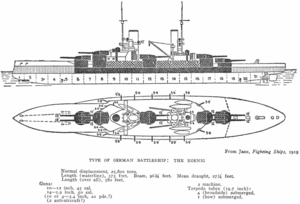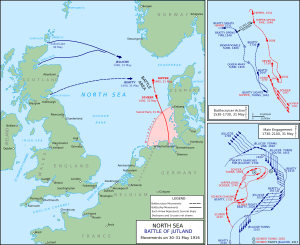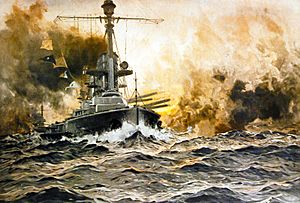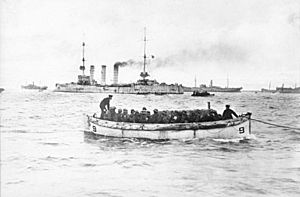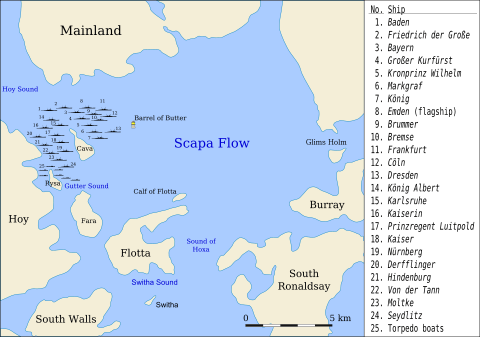SMS Kronprinz facts for kids
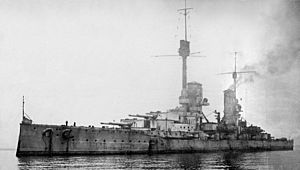
SMS Kronprinz Wilhelm in Scapa Flow 1919
|
|
Quick facts for kids History |
|
|---|---|
| Builder | Germaniawerft, Kiel |
| Laid down | November 1911 |
| Launched | 21 February 1914 |
| Commissioned | 8 November 1914 |
| Fate | Scuttled 21 June 1919 in Gutter Sound, Scapa Flow |
| General characteristics | |
| Class and type | König-class battleship |
| Displacement | |
| Length | 175.4 m (575 ft 6 in) |
| Beam | 29.5 m (96 ft 9 in) |
| Draft | 9.19 m (30 ft 2 in) |
| Installed power |
|
| Propulsion |
|
| Speed | 21 knots (39 km/h; 24 mph) |
| Range | 8,000 nmi (15,000 km; 9,200 mi) at 12 knots (22 km/h; 14 mph) |
| Complement |
|
| Armament |
|
| Armor |
|
The SMS Kronprinz was the last of four powerful battleships in the König class. These ships were part of the German Imperial Navy during World War I. Kronprinz means "Crown Prince" in English. The ship was named after Crown Prince Wilhelm. In June 1918, her name was officially changed to Kronprinz Wilhelm to honor him.
This battleship was built in November 1911 and launched on February 21, 1914. She officially joined the German Navy on November 8, 1914. This was just over three months after World War I began. Kronprinz had ten large 30.5 cm guns and could travel at a top speed of 21 knots (about 39 km/h).
Kronprinz and her three sister ships, König, Grosser Kurfürst, and Markgraf, took part in many important naval battles during the war. This included the huge Battle of Jutland in May and June 1916. Even though she was near the front of the German line, Kronprinz was not damaged in this battle.
Later, on November 5, 1916, a British submarine, HMS J1, hit her with a torpedo near Denmark. After repairs, she joined Operation Albion in October 1917. This was a big attack in the Baltic Sea. During this operation, Kronprinz fought the Russian battleship Tsesarevich and made it retreat.
After Germany lost the war, most of the German fleet was sent to Scapa Flow in Scotland. This was a British naval base. The ships were disarmed and had small crews. This happened while the Allies decided what to do with them in the Treaty of Versailles. On June 21, 1919, the German commander, Rear Admiral Ludwig von Reuter, ordered the fleet to sink their own ships. He did this to stop the British from taking them. Unlike many other ships, Kronprinz was never brought back up. Her wreck is still at the bottom of the harbor today.
Contents
Building and Features
The four König-class battleships were built because of a naval race with Britain. They were Germany's fourth generation of powerful dreadnought battleships. They were designed to be better than the earlier Kaiser-class ships. The main improvement was how the main guns were placed.
Kronprinz weighed about 25,796 tons when empty and 28,600 tons when fully loaded. She was 175.4 meters (575 ft) long. Her width was 29.5 meters (97 ft) and she sat 9.19 meters (30 ft) deep in the water. The ship was powered by three steam turbines. These turbines got steam from three oil-fired and twelve coal-fired boilers. This gave her a total power of 33,980 kilowatts (45,570 horsepower). This power allowed her to reach a top speed of 21 knots (39 km/h). The ship could travel 8,000 nautical miles (15,000 km) at a speed of 12 knots (22 km/h). Her crew included 41 officers and 1,095 sailors.
The ship had ten 30.5 cm guns in five twin turrets. Two turrets were at the front, two at the back, and one in the middle. For smaller targets, she had fourteen 15 cm quick-firing guns and six 8.8 cm quick-firing guns. These were placed in armored sections along the sides. Like other big warships of that time, she also had five 50 cm torpedo tubes. One was in the front, and two were on each side, all underwater.
Kronprinz was protected by strong Krupp steel armor. Her main armored belt was 35 cm (14 in) thick in the middle. This protected the engines and ammunition storage. It was thinner at the front (18 cm) and back (12 cm). The main deck armor was 10 cm (3.9 in) thick in the middle. It was thinner at the front and back (4 cm). The main gun turrets had 30 cm (12 in) of armor on their sides. The command tower at the front also had 30 cm (12 in) thick sides.
Ship's Journey and Battles
Kronprinz was built at the Germaniawerft shipyard in Kiel. Her keel was laid in May 1912. She was launched on February 21, 1914. Crown Princess Cecile officially named the ship. Work on the ship was sped up after World War I started in mid-1914. She was finished and joined the High Seas Fleet on November 8, 1914.
Kronprinz finished her tests in January 1915. Her first mission was a fleet trip into the North Sea in March. She also helped protect ships laying mines in April and May. In August 1915, Constanz Feldt became her captain. The ship took part in several more uneventful trips into the North Sea.
On April 24, 1916, Kronprinz helped cover a raid on the English coast. German battlecruisers attacked the town of Lowestoft. The British fleet was warned and started to move. Admiral Reinhard Scheer, the German commander, decided to turn back to Germany.
Battle of Jutland
Kronprinz was part of the huge Battle of Jutland on May 31 and June 1, 1916. The German fleet wanted to draw out and destroy a part of the British fleet. Kronprinz was the last ship in the front group of German battleships.
Around 4:00 PM, German and British battlecruisers met and started fighting. Two British battlecruisers, Indefatigable and Queen Mary, were destroyed. The German battlecruisers then sailed south to lead the British ships towards the main German fleet.
At 5:45 PM, the German fleet opened fire. Kronprinz was not close enough to shoot at the British battlecruisers. Instead, she and other German battleships fired at British light cruisers. From 5:51 PM to 6:00 PM, Kronprinz fired at HMS Dublin. Then she aimed at the battleship Malaya. She fired at Malaya for 13 minutes but only hit her once. During this time, many shells landed close to Kronprinz, but none hit her.
Around 7:00 PM, British destroyers tried to attack the German ships with torpedoes. Kronprinz avoided two torpedoes fired by Onslow. The German cruiser Wiesbaden was badly damaged. Kronprinz and her sisters fired heavily at British cruisers trying to help Wiesbaden. During this fight, the British armored cruiser Defence was hit by many large shells. It exploded and was destroyed. Kronprinz then fired at Warrior, damaging her badly. Warrior had to leave the battle and sank the next morning.
By 8:00 PM, the German fleet turned east to get away from the British. Kronprinz was shaken by near misses but held her fire because of bad visibility. The German fleet managed to get through the British light forces. They reached German ports a few hours later.
Kronprinz fired 144 shells from her main guns during the battle. She did not use her smaller guns. Of the four König-class ships, only Kronprinz was not damaged during the Battle of Jutland.
Later Operations
On August 18, 1916, Kronprinz joined an operation to bombard Sunderland in England. Admiral Scheer wanted to repeat the Jutland plan. He hoped to draw out and destroy British battlecruisers. But the British knew the German plans and sent their whole fleet. Scheer turned back to Germany to avoid a big battle.
Kronprinz took part in two more fleet operations in July and October 1916. After training in the Baltic Sea, she helped rescue two German submarines stranded on the Danish coast. On the way back, on November 5, 1916, the British submarine J1 hit Kronprinz with a torpedo. The torpedo hit near the front gun turret. About 250 tons of water flooded into the ship. Kronprinz kept her speed and made it to port. She was repaired in Wilhelmshaven from November 6 to December 4.
In March 1917, her sister ship Grosser Kurfürst accidentally rammed Kronprinz. This caused more flooding, about 600 tons of water. She was repaired again from March 6 to May 14. In September, Kronprinz was sent for training in the Baltic. Then she joined the special unit for Operation Albion.
Operation Albion
In September 1917, the German navy decided to clear out Russian naval forces in the Gulf of Riga. They planned to capture the Baltic islands of Ösel and Moon. On September 18, the order was given for a joint army and navy attack. The main naval force included Moltke and the battleships of the High Seas Fleet. This included the four König-class ships and the new battleship Bayern. The entire force had about 300 ships and over 100 aircraft.
The operation began on October 12. König anchored off Ösel and landed soldiers. By 5:50 AM, König and other ships, including Kronprinz, began firing at Russian coastal guns. The goal was to secure the channel between Moon and Dagö islands. This would block the escape route for Russian ships. Both Grosser Kurfürst and Bayern hit mines. Bayern was badly damaged and had to leave for repairs. After the bombardment, Kronprinz refueled.
On October 16, the Germans decided to clear the Russian ships in Moon Sound. These included two old Russian battleships. Kronprinz and König, along with cruisers, were sent to fight them. They arrived on October 17. A deep Russian minefield blocked their way. The Germans were surprised that the Russian battleships' guns could shoot farther than their own. The Russian ships kept their distance, making it hard for the Germans to fire back.
By 10:00 AM, German minesweepers cleared a path. Kronprinz and König entered the bay. Around 10:15 AM, Kronprinz opened fire on Tsarevitch and Bayan, hitting both. König sank Slava. The Russian ships were hit many times. At 10:30 AM, the Russian commander ordered them to retreat.
On October 18, Kronprinz ran aground slightly, but the damage was not serious. By October 20, the islands were under German control. The German command ordered the battleships to return to the High Seas Fleet. On October 26, Kronprinz ran aground more seriously on the way back to Kiel. She reached Kiel on November 2 and was repaired from November 24 to January 8, 1918.
Final Days and Scuttling
On January 27, 1918, Kaiser Wilhelm II ordered the ship to be renamed Kronprinz Wilhelm. This was to honor the Crown Prince. The ship was officially renamed on June 15, 1918.
In April 1918, the German fleet, including Kronprinz, went on a mission to attack British convoys. They hoped to catch a part of the British fleet alone. But the convoy had left a day later than expected. The German fleet returned to base without finding anything.
Kronprinz had no more major actions for the rest of the war. She went for maintenance in Kiel in mid-September.
Kronprinz Wilhelm and her three sister ships were supposed to take part in a final battle in October 1918. This was just days before the end of World War I. The German fleet planned to attack the British Grand Fleet. The German commander, Grand Admiral Scheer, wanted to cause as much damage as possible. He hoped this would give Germany a better position in peace talks.
However, many tired sailors felt this operation would stop the peace process. On October 29, 1918, sailors on several battleships, including Kronprinz Wilhelm, refused to obey orders. This mutiny forced the admirals to cancel the operation. The Kaiser famously said, "I no longer have a navy."
After Germany surrendered in November 1918, most of the High Seas Fleet was sent to Scapa Flow in Scotland. This was a British naval base. The ships were disarmed, and their crews were greatly reduced.
The fleet stayed there while the Treaty of Versailles was being negotiated. Rear Admiral Ludwig von Reuter, the German commander, believed the British would seize the ships on June 21, 1919. This was the deadline for Germany to sign the peace treaty. He did not know the deadline had been extended. So, on the morning of June 21, Reuter ordered his ships to be sunk.
Kronprinz Wilhelm sank at 1:15 PM. British guards tried to stop the Germans. They shot and killed a stoker from Kronprinz Wilhelm. In total, nine Germans were killed and twenty-one wounded. The remaining 1,860 German sailors were taken prisoner.
Kronprinz Wilhelm was never raised for scrap metal. She and two of her sisters sank in deeper water than other ships, making salvage difficult. World War II stopped all salvage work. After the war, it was too expensive to raise the deep wrecks. The rights to salvage the wreck were sold to Britain in 1962.
Kronprinz Wilhelm and her sisters are one of the few sources of radiation-free steel. This is because they sank before atomic weapons were used. This special steel is sometimes used in scientific devices.
The wreck of Kronprinz Wilhelm is a popular spot for scuba divers. It lies between 12 and 38 meters (39 and 125 ft) deep. Divers are not allowed to take items from the wrecks. In 2017, archaeologists studied Kronprinz Wilhelm and other wrecks. They used sonar and underwater robots to see how the wrecks are changing.
The company Scapa Flow Salvage owned the wreck. In 1981, they sold the rights to Tommy Clark, a diving contractor. In 2019, Clark listed the wreck for sale on eBay. It had a "buy-it-now" price of £250,000. The wrecks of Kronprinz Wilhelm and her two sisters were sold for £25,500 each to a company from the Middle East.
Images for kids
See also
 In Spanish: SMS Kronprinz Wilhelm para niños
In Spanish: SMS Kronprinz Wilhelm para niños


